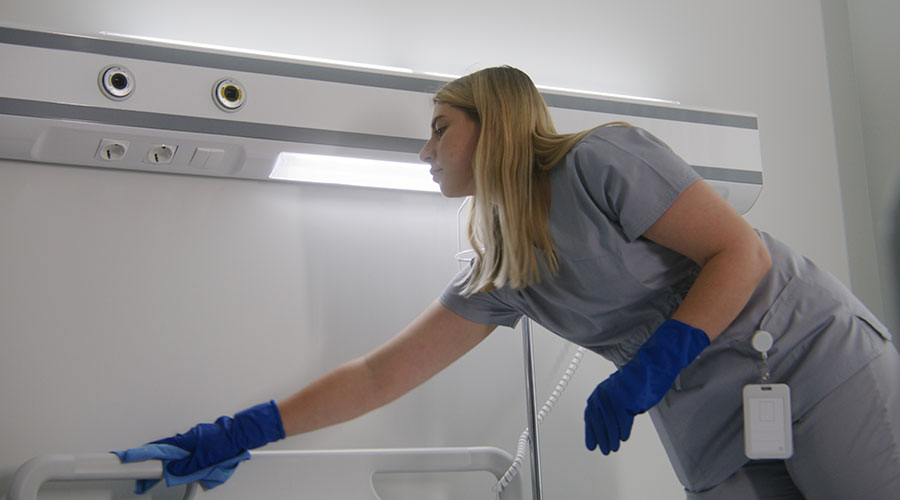Regulatory agencies such as The Joint Commission and the U.S. Food and Drug Administration require healthcare professionals to follow the manufacturer's instructions for use (IFU) for cleaning and disinfection. Yet issues surrounding these requirements remain.
The issues include a lack of understanding by surface material and product manufacturers on the basics of microbiology and the organisms that healthcare professionals are trying to destroy. A conflict also exists between IFUs and infection prevention guidelines and protocols developed by and used in individual healthcare facilities.
While the U.S. Environmental Protection Agency (EPA) has specific testing requirements for disinfectant manufacturers, they focus on the kill claims — or log reduction — of specific pathogens, including Mycobacterium tuberculosis, SARS-CoV-2 and Clostridioides difficile. This testing is typically conducted in a laboratory using nickel-sized discs or coupons of non-specific material.
These are not representative of medical devices, patient care products or assemblies of materials used in any given healthcare environment. And none of these tests look for compatibility with materials used in healthcare settings to evaluate potential damage at a microbial level. Instead, they test to see if a specific pathogen is killed in a set amount of time. Once the test method is concluded and log reduction is documented, kill claims are listed on the EPA registration product label.
Let's take the example of the universal patient bathroom, which has become a standard in healthcare facilities. First, we have a toilet without a lid. This is a plumbing building code requirement. Significant research about toilet plumes provides data about contamination that takes place when a toilet is flushed.
An invisible plume of aerosolized droplets of water and pathogens from human waste is forced up to five feet into the air, and those particles can remain suspended in the air for a short time before landing on surfaces within five feet of the toilet.
Logically, this should draw attention to the surrounding surfaces upon which contaminates might settle. Do the walls, floor and handrails support efficient and effective disinfection practices?
Deeper investigation reveals additional chinks in the armor. The ceramic tile that is routinely used in patient bathrooms creates hundreds of seams on the walls and floor and provides a supportive environment for microbes to attach.
The resulting environment is difficult if not impossible to clean and properly disinfect daily. Tile and grout require different methods of care and maintenance, as outlined by manufacturers in product care and maintenance documents. But these materials are not cleaned and disinfected the same way by every person or across healthcare facilities.
Healthcare facilities should advocate for a standardized format for IFUs and making the IFUs last for the lifespan of the product. The IFU should indicate when the IFU was last updated because that information also is important.
In addition, IFUs should not be too vendor-specific on the products that are recommended for cleaning. Instead, look at families of disinfectants, such as hypochlorous acid, quaternary ammonium compounds, and chlorine-based and hydrogen peroxide.
J. Darrel Hicks, BA, MESRE, CHESP, Certificate of Mastery in Infection Prevention, is the past president of the Healthcare Surfaces Institute. Hicks is nationally recognized as a subject matter expert in infection prevention and control as it relates to cleaning. He is the owner and principal of Safe, Clean and Disinfected. His enterprise specializes in B2B consulting, webinar presentations, seminars and facility consulting services related to cleaning and disinfection. He can be reached at darrel@darrelhicks.com, or learn more at www.darrelhicks.com.

 Healthcare Facilities Look to Future-Proof Facilities
Healthcare Facilities Look to Future-Proof Facilities Yale New Haven Health Experiences Data Breach
Yale New Haven Health Experiences Data Breach Rethinking Facilities: A New-Generation Approach to Behavioral Healthcare
Rethinking Facilities: A New-Generation Approach to Behavioral Healthcare ThedaCare to Open Medical Center in Fond du Lac, Wisconsin
ThedaCare to Open Medical Center in Fond du Lac, Wisconsin UF Health Hospitals Rely on Green Globes to Realize Their Full Potential
UF Health Hospitals Rely on Green Globes to Realize Their Full Potential